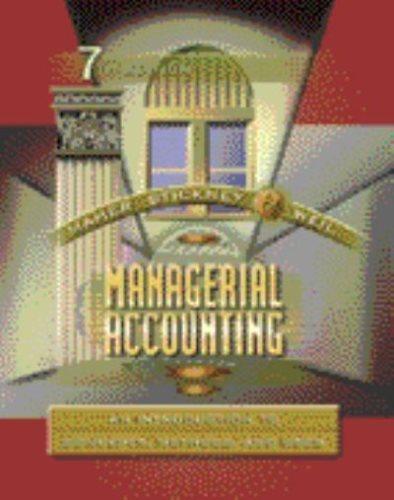Transfer Pricing: Custom Freight Systems (A)5 We can't drop our prices below $210 per hundred pounds. exclaimed
Question:
Transfer Pricing: Custom Freight Systems (A)5 "We can't drop our prices below
$210 per hundred pounds." exclaimed Greg Berman. manager of Forwarders, a division of C ustom Freight Systems. "Our margins are already razor thin. Our costs just won't allow us to go any lower. Corporate rewards our division based on our profitability and I won't lower my prices below $210."
Customer Freight Systems is organized into three divisions: Air Cargo provides air cargo services; Logistics Services operates distribution centers and provides truck cargo services; and Forwarders provides international freight forwarding services.
Freight forwarders typically buy space on planes from international air cargo companies. This is analogous to a charter company that books seats on passenger planes and resells them to passengers. In many cases freight forwarders will hire trucking companies to transport the cargo from the plane to the domestic destination.
Management believes that the three divisions integrate well together and are able to provide customers with one-stop transportation services. For example, a Forwarders branch in Singapore would receive cargo from a shipper, prepare the necessary documentation, and then ship the cargo on Air Cargo to the San Francisco Forwarders station.
The San Francisco Forwarders station would ensure the cargo passes through customs and ship it to the final destination with Logistics Services (see Exhibit 12.1 1 ).
Management evaluates each division separately and rewards division managers based on return on investment (ROD. Responsibility and decision-making authority are decentralized. Each division has a sales and marketing organization. Division sales people report to the Vice-President of Sales for Custom Freight Systems as well as a division sales manager. Custom Freight Systems feels that it has been successful motivating division managers by paying bonuses for high division profits.
Recently, the Logistics division was completing a bid for a customer. The customer had freight to import from an overseas supplier and wanted Logistics to submit a bid for a distribution package that included air freight from the supplier, receiving the freight and providing customs clearance services at the airport, warehousing, and distributing to customers.
Because this was a contract for international shipping, Logistics needed to contact different freight forwarders for shipping quotes. Logistics requested quotes from the Forwarders division and United Systems, a competing freight forwarder. Divisions of Custom Freight Systems are free to use the most appropriate and cost-effective suppliers.
Logistics received bids of $210 per hundred pounds from Forwarders and $1X5 per hundred from United Systems. Forwarders specified in its bid that it will use Air Cargo, a division of Custom Freight Systems. Forwarder's variable costs were $175 per hundred, which included the cost of subcontracting air transportation. Air Cargo, which was experiencing a period of excess capacity, quoted Forwarders the market rate of $155. Typically, Air's variable costs are 60 percent of the market rate.
The price difference between the two different bids alarmed Susan Burns, a contract manager at Logistics. Burns knows this is a competitive business and is concerned because the total difference between the high and low bids was a lot of money for the contract estimated at 4,160,000 pounds during the first year. Burns contacted Greg Berman, the manager of Forwarders, and discussed the quote. "Don't you think full markup is unwarranted due to the fact that you and the airlines have so much excess capacity?" Burns complained.
Burns soon realized that Berman was not going to drop the price quote. "You know how small margins are in this business. Why should I cut my margins even smaller just to make you look good?" Berman asked.
Burns went to Bennie Espinosa, vice-president of Custom Freight Systems and chairperson for the corporate strategy committee. "That does sound strange," said Espinosa.
"1 n eed to examine the overall cost structure and talk to Berman. I'll get back to you by noon Monday."
a. Which bid should the Logistics division accept: the internal bid from the Forwarders division or the external bid from United Systems?
b. What should the transfer price be on this transaction?
c. What should Bennie Espinosa do ?
d. Do the reward systems for the division managers support the best interests of the Forwarders division and the best interests of Custom Freight Systems? Give examples that support your conclusion.
Step by Step Answer:

Managerial Accounting An Introduction To Concepts Methods And Uses
ISBN: 9780030259630
7th Edition
Authors: Michael W. Maher, Clyde P. Stickney, Roman L. Weil, Sidney Davidson





